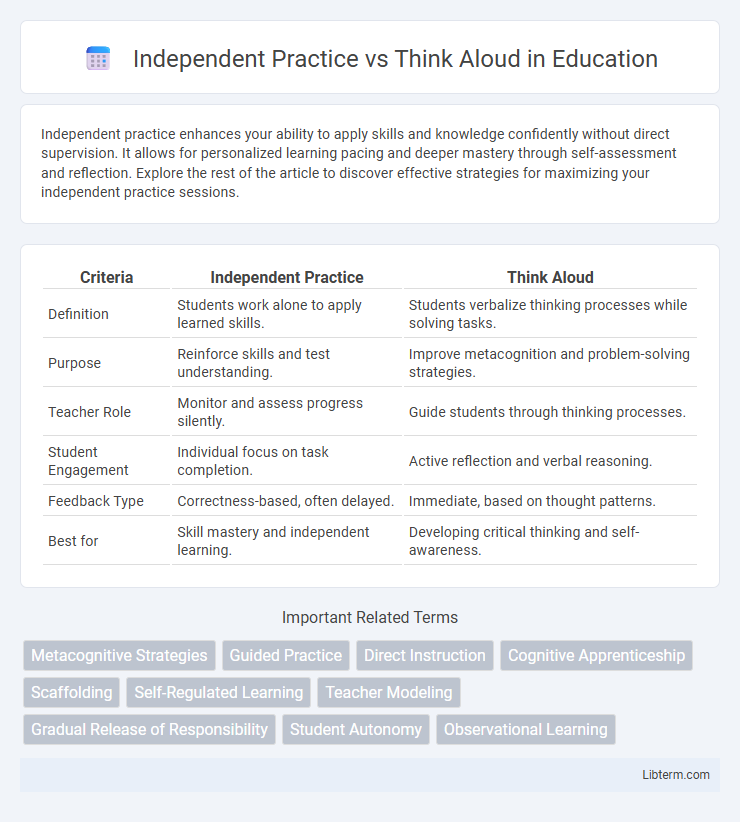Independent practice enhances your ability to apply skills and knowledge confidently without direct supervision. It allows for personalized learning pacing and deeper mastery through self-assessment and reflection. Explore the rest of the article to discover effective strategies for maximizing your independent practice sessions.
Table of Comparison
| Criteria | Independent Practice | Think Aloud |
|---|---|---|
| Definition | Students work alone to apply learned skills. | Students verbalize thinking processes while solving tasks. |
| Purpose | Reinforce skills and test understanding. | Improve metacognition and problem-solving strategies. |
| Teacher Role | Monitor and assess progress silently. | Guide students through thinking processes. |
| Student Engagement | Individual focus on task completion. | Active reflection and verbal reasoning. |
| Feedback Type | Correctness-based, often delayed. | Immediate, based on thought patterns. |
| Best for | Skill mastery and independent learning. | Developing critical thinking and self-awareness. |
Understanding Independent Practice
Independent Practice enhances learners' ability to internalize concepts by allowing self-guided repetition and application of skills. This method promotes deeper cognitive engagement, leading to improved retention and problem-solving capabilities. Teachers can monitor progress and tailor support based on individual performance during independent tasks.
Defining Think Aloud Strategy
Think Aloud Strategy involves learners verbalizing their thoughts, reasoning, and problem-solving processes while engaging with a task, enhancing metacognitive awareness and comprehension. This method contrasts with Independent Practice, where learners work silently and internally process information, emphasizing autonomy and skill reinforcement. Employing Think Aloud techniques promotes active engagement and allows instructors to identify misconceptions in real-time for targeted interventions.
Key Differences Between the Two Approaches
Independent Practice emphasizes learner autonomy by allowing individuals to apply concepts without external guidance, fostering self-reliance and problem-solving skills. Think Aloud involves verbalizing thoughts during problem-solving, providing insights into cognitive processes and facilitating immediate feedback and instructor intervention. The key difference lies in Independent Practice promoting internalization through silent reflection, while Think Aloud prioritizes externalizing reasoning for real-time assessment and correction.
Benefits of Independent Practice
Independent practice enhances student retention by encouraging active engagement and self-reliance in skill development. It fosters critical thinking and problem-solving abilities by allowing learners to apply concepts without immediate guidance. This method builds confidence and autonomy, leading to improved long-term mastery and academic performance.
Advantages of Think Aloud in Learning
Think Aloud encourages active cognitive engagement by prompting learners to verbalize their thought processes, which enhances metacognitive awareness and deepens comprehension. This method facilitates immediate identification and correction of misconceptions, allowing instructors to provide targeted feedback in real-time. It also promotes the development of critical thinking skills and self-regulation, leading to improved problem-solving abilities and long-term retention of information.
When to Use Independent Practice
Independent practice is most effective when students have already been introduced to new concepts and demonstrated basic understanding through guided activities. It reinforces skill mastery by allowing learners to apply knowledge autonomously, promoting confidence and retention. Use independent practice after sufficient modeling and scaffolding to solidify comprehension before progressing to more complex tasks.
Ideal Scenarios for Think Aloud
Think Aloud is ideal in scenarios where monitoring cognitive processes enhances learning, such as during problem-solving or reading comprehension tasks. It supports metacognitive awareness by allowing learners to verbalize thoughts, facilitating identification of errors and misconceptions in real-time. This method is especially effective in collaborative settings and formative assessments where instructor feedback can target specific thinking strategies.
Impact on Student Engagement
Independent practice fosters deep cognitive engagement by allowing students to apply concepts autonomously, enhancing focus and self-regulation. Think Aloud strategies promote active metacognitive engagement by encouraging students to verbalize their thought processes, increasing awareness and interactive learning. Both methods significantly impact engagement, with independent practice strengthening individual accountability and Think Aloud boosting collaborative dialogue.
Combining Both Methods for Enhanced Learning
Combining Independent Practice with Think Aloud techniques enhances cognitive engagement and reinforces comprehension by allowing learners to articulate their thought processes while independently solving problems. This dual approach promotes deeper metacognitive awareness and self-regulation, leading to improved retention and problem-solving skills. Educators report that integrating both methods results in more effective skill acquisition and critical thinking development across diverse learning environments.
Choosing the Right Approach for Your Classroom
Choosing the right approach for your classroom hinges on the learning objectives and student needs. Independent practice fosters autonomy and allows students to apply skills without assistance, reinforcing mastery through repetition. Think Aloud promotes metacognitive awareness by modeling cognitive processes, which benefits students struggling with comprehension or problem-solving strategies.
Independent Practice Infographic

 libterm.com
libterm.com